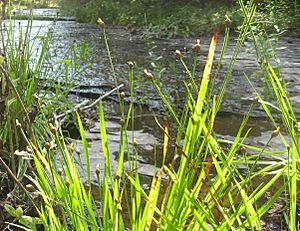Tennessee yellow-eyed grass facts for kids
Quick facts for kids Tennessee yellow-eyed grass |
|
|---|---|
 |
|
| Conservation status | |
| Scientific classification | |
| Genus: |
Xyris
|
| Species: |
tennesseensis
|
The Tennessee yellow-eyed grass (scientific name: Xyris tennesseensis) is a very rare flowering plant. It belongs to the Xyridaceae family. You can find this special plant in a small part of the southeastern United States. This includes parts of Alabama, Georgia, and Tennessee.
This plant is officially listed as an endangered species. This means it is in danger of disappearing forever. Its main problem is that its home, or habitat, is being lost or damaged.
Contents
What Does Tennessee Yellow-Eyed Grass Look Like?
Tennessee yellow-eyed grass is a plant that lives for many years. It grows to be about 30 to 70 centimeters (12 to 28 inches) tall. Its stem is thick and fleshy at the bottom, like a small bulb.
The leaves are long and thin. They grow from the swollen base of the stem. They can be up to 45 centimeters (18 inches) long but are usually less than a centimeter (0.4 inches) wide. These leaves are flat, but sometimes they twist. They are green with reddish or pink parts at their base.
At the very top of the stem, there is a cone-shaped flower part called an inflorescence. It is covered in tough, brown scales. The flowers inside are a pale yellow color.
Life Cycle and Reproduction
Each cone-like spike usually produces one flower per day, sometimes two. These flowers open for only a short time. They open in the late morning and close by mid-afternoon. The plant blooms in August and September.
Tiny insects help the plants make seeds. This process is called pollination. One important insect is a type of sweat bee called Lasioglossum zephyrus. Scientists have seen this bee opening the flower buds even before they fully open. This way, the bee gets the pollen first!
Where Does Tennessee Yellow-Eyed Grass Live?
This plant likes to grow in open, wet places. You can find it along streambanks, in wet spots where water seeps out of the ground, in fens (a type of wetland), and in wet meadows.
The soil where it grows is usually thin. It sits on top of calcareous rock, which means the rock has a lot of calcium. Unlike most other Xyris plants, which prefer acidic soils, Tennessee yellow-eyed grass grows in neutral to basic soils.
Why Is This Plant in Danger?
There are only about 16 to 25 groups of this plant left in the three US states. Some groups have already disappeared completely. Others are shrinking, and many are in danger of being destroyed.
One big threat is habitat destruction from timber operations. This includes clearcutting, where all the trees are cut down. Many areas where this plant lives in Tennessee are owned by timber companies. When trees are removed, the soil dries out. This makes it impossible for this wetland plant to survive.
Building and maintaining roads also harms the plant. This includes using herbicides (chemicals that kill plants) along roadsides.
The plant needs lots of sunshine to grow and sprout. In some areas, larger trees and bushes are growing too close. This blocks the sunlight the yellow-eyed grass needs.
Protecting Tennessee Yellow-Eyed Grass
To help this plant survive, people are working on land management. This includes clearing away brush and removing exotic plant species. One harmful plant is Nepal grass (Microstegium vimineum), which can take over the plant's habitat.
Interactions with Other Species
As mentioned, the flowers of Tennessee yellow-eyed grass are visited by a type of sweat bee called Lasioglossum zephyrum. This bee is known for opening the plant's flowers by force. This gives the bee first access to the pollen inside.


